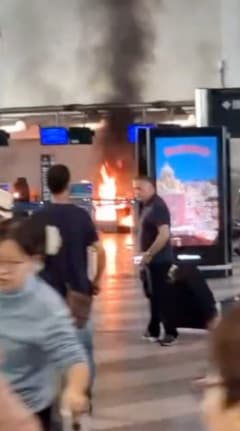Analyzing Airport Security Amidst the Flames: A Milan Incident Sparks Discussion
 The Tech Times
The Tech Times
In a world where travel is a seamless part of our lives, airports are often seen as bastions of security and order. However, recent events at Milan's airport have called this perception into question as an unexpected fire erupted at a check-in desk, captivating the attention of travelers and social media alike.
The Incident Unfolds
The footage surfacing from the Milan airport is both startling and alarming. It shows a man being knocked to the ground after reportedly smashing an advertisement screen, with the conflagration of flames serving as a fiery backdrop. For many, this incident may seem like an isolated case of disruption. However, it raises significant questions about safety protocols and the ability of airports to manage unexpected crises.
Historical Context: A Pattern of Airport Disruptions
To understand the implications of this event, it's crucial to examine it within the broader historical context of airport disruptions. Airports, being high-traffic, high-security environments, have long been susceptible to a range of disturbances—from technical failures and power outages to more serious security breaches.
One notable incident that comes to mind is the 2017 power outage at Hartsfield-Jackson Atlanta International Airport, which resulted in the cancellation of over 1,000 flights. More tragically, the 2016 bombings at Brussels Airport highlighted the vulnerabilities in airport security, leading to a global reassessment of safety measures.
These events, among others, have driven advancements in technology and security protocols, with airports adopting more sophisticated surveillance systems, emergency response strategies, and public awareness campaigns. Yet, as the Milan incident reminds us, no system is infallible, and the human element—whether through intentional disruption or inadvertent error—remains a critical factor.
The Role of Technology in Modern Airport Security
In recent years, technology has played an increasingly vital role in enhancing airport security and efficiency. From AI-driven facial recognition systems to advanced baggage screening technologies, airports have invested heavily in ensuring the safety of passengers and staff.
However, this reliance on technology can also present challenges. As seen in Milan, a simple act of vandalism—such as damaging an advertisement screen—can have unforeseen consequences, leading to chaos and potential safety hazards. This highlights the need for a balanced approach that combines technological solutions with human oversight and intervention.
Conclusion: A Call for Comprehensive Safety Strategies
The Milan airport incident serves as a stark reminder of the unpredictable nature of security threats and the need for comprehensive safety strategies that encompass both technological and human elements. As airports continue to evolve and adapt, they must remain vigilant and proactive in identifying potential vulnerabilities and mitigating risks.
Ultimately, the goal should be to create an environment where passengers can feel secure and confident in their travel experience. This requires an ongoing commitment to innovation, collaboration, and vigilance from all stakeholders involved in airport operations.
In the wake of the Milan incident, it is imperative that we continue to examine and improve our approaches to airport security. By doing so, we can ensure that airports remain safe, efficient, and resilient in the face of both expected and unforeseen challenges.
Subscribe to my newsletter
Read articles from The Tech Times directly inside your inbox. Subscribe to the newsletter, and don't miss out.
Written by
